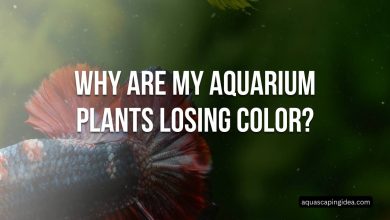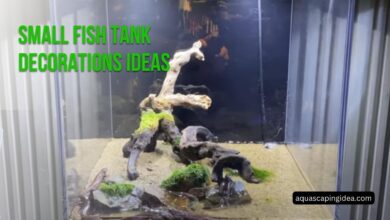Background Plants For Nano Aquarium

Tiny in scale yet tremendous in impact, nano aquariums let your imagination run wild condensing aquatic artistry. But aquascaping such pint-sized environments poses distinct challenges – restricted dimensions limit plant choices while amplification of errors keeps margins for error slim. This guide explores how to select backgrounds to enhance nano tanks under 6 gallons. Discover ideal smallest scale varieties thriving with basic care perfect for crystallizing focal visions even in cramped quarters. Soon you’ll be immerse in your own desktop or countertop aquatic oasis.
Benefits of Nano Planted Aquariums
Thanks to modern equipment and plant variety advancements, spectacular nano designs once exclusively the domain of experts now lie within reach of casual hobbyists. And planted nano tanks under 5 gallons provide perfect vehicles for creatively expressing your inner aquascaper. Consider the advantages of going small over traditional larger setups:
● Greater variety installation flexibility – open rims allow unconventional emergent or HOB options
● Lower startup equipment costs – affordable specialty nano filtration available
● Artistically amplified drama through scaled effects
● Desktop or countertop self-contained ecosystems
● Fundamentals teaching tools for aquascaping beginners
● Foster closer observation of mini-world dynamics
Maximizing Limited Dimension
In standard sized aquariums, background plants stretch vertically to accentuate depth and scale. But nano tanks afford less than a foot of rear elevation before necessitating midground transition species. This demands careful selection of compact varieties to realize your intended aesthetic within narrow confines.
Tricks to visually maximize nano depth include angling plants towards light sources, incorporating slope techniques on one rear corner and using dwarfed driftwood branches to push boundary borders. Mixing fine, medium and broad leaf shapes also conveys enhanced scale. Hardy varieties adaptable to nano parameters help beginners succeed.
Picking Suitable Nano Background Plants
Visually expanding horizons in nano tanks starts with choosing backgrounds able to withstand their amplified conditions. High surface area to water volume ratios make parameters in these mini ecosystems far less stable. Slow growing plants fade while faster varieties outpace limited nutrients. Lush leafed stems can rapidly choke flow.
Yet hardy nano suitable options exist if you know what adaptations to prioritize. Use these considerations when selecting background plants for small scaled aquascapes:
Adaptability to Fluctuating Conditions
Favor resilient plants able to withstand considerable parameter fluctuations from such factors as:
● Water evaporative concentration rising TDS, GH, pH
● Organic waste buildup between changes
● Temperature variability from equipment heat
Steady moderate growth patterns The slower metabolism of some varietals make them ideal for nano climes where pruned cuttings risk unbalancing delicate equilibrium. Look for moderate growers unlikely to drastically wane or overtake tank.
Low Light Adaptability While specialty nano lamps provide intense light, standard household LEDs often suffice given water clarity for viewing. Prioritize adaptable low to moderate light options.
petite Scaled Varieties Dwarf cultivars and naturally diminutive wild types prevent proportions overwhelming nano tanks. Compact growth matches other small scale hardscape.
Undemanding Root Requirements
Space limitations necessitate careful ferts and substrate dosing. Seek out less root reliant water column feeders over heavy root plants.
Suitable Species Spotlight
The following time-tested aquatic varieties check the boxes for prospering as carefree nano backgrounds if given basics like fertilization.
Java Fern ‘Nana’ & ‘Needle Leaf’ Tough, hardy, low light ferns that thrive attached to nano suitable hardscape. Both stay under 6 inches at maturity with graceful texture. Rhizome feeds from water.
Anubias Nana & Anubias Barteri ‘Coffeefolia’ Ever popular anubias plants possess durable leaves on petite rhizomes that cling to nano tank decor. Varieties like Nana and Coffeefolia reach just 3-6 inches maximum.
Bucephalandra ‘Mini Coin’ Hot newer aquascaping plant perfect for nano tanks. Lush little leaves on tiny rhizomes thrive even in low tech setups staying under 3 inches. Enhance hardscape when attached.
Hydrocotyle Tripartita ‘Japan’ This dwarf pennywort relative blankets tank floors with rapid spreading small scalloped leaves, spilling attractively over edges. Tough, hardy, fast growing adaptable stem.
Hemianthus Micranthemoides Pearlweed carpets the front with lush lawn when planted densely. Max height under 3 inches. Spreads readily filling out nano scale ground cover level.
Rotala Macrandra Variegated Delicate stems quickly send shoots up backwalls to 6 inches maximum. Leaves brightly variegated lending pop of color while softening rear focal points.
Proserpinaca Palustris Vibrant green, dense, finely divided leaves on rapidly extending lateral stems create bushy rear wall thicket topping out around 4 inches tall.
Eleocharis Acicularis ‘Mini’ This ultra dwarf hairgrass variety forms an emerald carpet less than 3 inches tall. Dense stands convey larger scale once established while anchoring the foreground.
Marsilea Crenata Lovely four leaf clovers spread to blanket nano floors with tiny lush foliage under an inch high. Ideal lush accent carpeting between hardscape.
Mix and Match for Drama With a palette of suitable nano species selections on hand, you can choreograph vibrant petite planted landscapes. Arrange a variety of leaf shapes, slopes and scale variations to realize your aquascaping vision within a pint sized water box.
Consider combining:
● Drifting dwarf Java fern anchoring sculpted spider wood branch
● Mini bucephalandra softly clothing a weathered dragon stone
● Undulating hairgrass meadow
● Foreground patches of Marsilea crenata
● Sweeping pearl weed layered under color-popping rotala stems
● Flowing carpet of Japan pennywort spilling evenly over the rim
This mockup conveys the dramatic scale illusion such arrangements create even in mini volumes when following basic design principles:
Propagating Nano Suitable Plants
Maintaining equilibrium between plant mass and water volume remains an ongoing balancing act. As varieties thrive and spread, pruning and propagating maintains optimal conditions. And adding accent extras expands possibilities!
Pearlweed, pennywort, hairgrass and marsilea all propagate from cuttings. Simply replant clippings after trimming to fill gaps or create new formations. Pearlweed and hairgrass also generate side shoots from substrate runners.
Anubias, buce and java fern readily clone new plants by dividing rhizome sections during pruning. Each cutting should retain 2-3 leaves. Reattach extras with cyanoacrylate gel or cotton thread to hardscape decor.
Infrequent stem trimmings from rotala and mermaid weed quickly generate fresh shoots. Replant tops while bottoms often form bushy secondary shoots.
Essential Nano Aquarium Care Tips
While selecting suitable plants forms the cornerstone, adhering to fundamentals still proves vital for their sustained success. Give your nano backgrounds the best shot by providing:
● Suitable Fine Textured Substrate 1-1 1⁄2 inches deep
● Twice weekly dosing with comprehensive supplement
● 20% Weekly water changes with remineralized RODI or distilled H2O
● Adequate filtration adjustable flow
● Consistent lighting duration 8 hours daily
● Clean up crew critters like shrimp and snails
Avoiding Pitfalls
Nano tanks leave little margin for errors often amplified from larger established systems. Steer clear of common missteps like:
● Disrupting hardscape and substrate once flooded
● Overcrowding plants dense varieties
● Underestimating rapid growth filling small spaces fast
● Infrequent water changes concentrations can quickly stall growth
● Adding too large algae eaters outweighing plants
Troubleshooting Tricks
If issues arise with your scaled down underwater oasis, consider the following quick diagnostics and remedies:
Cloudy Water, Green Water Blooms
✓ Increase water change frequency to 30% twice weekly
✓ Install micron filtration pad supplement
✓ 3-4 day blackout, then reduce duration of light exposure
Yellowing Leaves
✓ Test GH, KH parameters and adjust mineral dosing
✓ Increase comprehensive fertilizer to twice a week
✓ Rule out wet feet rhizome issues
Stunted Growth
✓ Increase light intensity if possible
✓ Introduce root supplement tabs
✓ Propagate and restart with fresh stems
Algae Outbreaks
✓ Manually clean leaves daily
✓ Reduce light duration further
✓ Remove decaying plant matter triggering blooms
✓ Introduce clean up crew like amanos, nerites
Never Set It and Forget It
While less demanding than high tech versions, nano nature aquariums still require attentive basic care. Maintain lush growth by consistently adhering to the following habits:
● Twice weekly small volume water changes
● Monthly filter cleaning
● Remove plant debris
● Dose ferts
● Propagate overgrowth
● Observe inhabitants and plants daily
● Adjust parameters promptly
Last Words
By starting out on the right foot selecting suitable petite plants and providing their essential needs, soon your daily nano observation becomes meditation fueling further inspiration. When adversity arises, don’t hesitate making adjustments reflecting the amplified reality of nano climes. Vibrant good health will return quickly if caught early. Then you can get back to enjoying the hypnotizing company of mini LOTUS blossoms and schooling chilli rasboras to the soundtrack of serenely trickling water. Your nano slice of aquatic zen awaits!
FAQs
What makes nano tanks different than standard aquariums?
Nano aquariums under 5 gallons have amplified conditions compared to larger setups. Small water volumes lead to faster parameter fluctuations. Surface area to water ratios being higher means more rapid evaporation and waste concentration without diligent, frequent water changes. Light and CO2 balancing also proves more precarious.
What background plants work best in nano planted aquariums?
Mini aquatic plant varieties that stay compact under 6 inches tall work best, such as dwarf Java fern, anubias nana, bucephalandra species and the smallest aquarium grade crypts. These make excellent nano tank background choices. Slow growing adaptive varieties prevent rapid overgrowth.
Are there special filters made for nano tanks?
Yes, several specialty nano filters exist to provide adjustable flow perfect for small tank inhabitants. Popular options include ZooMed 501 turtle filters, Azoo palm filters and Deep Blue professional nano canisters. Sponge filters also work well to protect shrimp and small fish.
Can I use regular gravel and ferts dosing nano aquariums?
Small sized substrates like ADA Aquasoil powders or Jos Versele’s line of nano substrates help prevent anaerobic gas pockets in shallow nano gravel beds. They also contain tailored nutrient levels for such constrained spaces. Use lean liquid ferts avoiding excess.
What causes cloudy nano tank water and how can I clear it fast?
Green water algae blooms and bacterial clouding commonly trigger nano water clarity issues. Fix these by increasing water change frequency, adding micron pad filtration, 3-4 day blackouts and scrubbing hardscape film accumulation. Reduce lighting durations.

